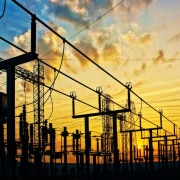Power Up: Utilities Must Get Ready To Meet Rising Energy Demand

Written by Guilhermme Lisboa and Aman Sheth
Over the past few decades, U.S. energy demand has remained stagnant. Upcoming decades, however, will tell a much different story.
In fact, the country is already seeing spikes in energy use. In 2023, for example, grid planners virtually doubled their five-year forecast for load growth (from 2.6% to 4.7%). By 2028, they predict peak demand growth of 38 GW—and this growth will continue to trend upward. The U.S. Energy Information Administration estimates that energy demand will rise to 4.112 billion kWh this year and will stretch to 4.123 billion kWh next year.
What’s Driving Higher Energy Demand?
As the economy, businesses and consumers become more electrified, they create new kinds of energy loads. Here are three examples:
Electric Vehicle
Electric vehicles (EVs) are on the move—literally and figuratively. As more EVs hit the road, they’re also making energy mobile, consuming energy from different places on the grid at different times, depending on when and where they charge. This requires dynamic, real-time control over the grid so electrons can be pushed to wherever they’re needed.
Data Centers
As data centers handle new demands ranging from artificial intelligence (AI) to virtual reality (VR), they play an increasingly critical role in our digital world—and they consume more power. According to commercial real estate advisor Newmark, U.S. data center power consumption will reach 35 GW by 2030, which is almost double the energy they consumed in 2022. As the world becomes more tech-forward, data center deployment will continue.
Industrial Processes
With record investments in U.S. manufacturing supported by key legislation like the Infrastructure Investment and Jobs Act (IIJA), the Creating Helpful Incentives to Produce Semiconductors (CHIPS) and Science Act and the Inflation Reduction Act (IRA), the industry is experiencing significant momentum. And many manufacturing and industrial processes require heat—which will require more energy.
What This All Means for Power Transmission and Distribution Companies
The time to prepare for more energy demand is now. Grid infrastructure must be ready to support double-digit load increases in relatively short order, which requires rapid planning for and construction of new power generation and transmission systems.
More Power Generation
As energy demand increases, more power generation will be needed. Because energy transition is moving consumers away from fossil fuels and toward sustainable energy, much of this power generation may happen by adding more wind farms, solar farms and other types of renewable energy sources. Traditional power plants, such as gas-fired plants, will also be needed.
More Transmission Lines
Even more challenging than increasing generation is increasing the country’s number of transmission and distribution lines, which carry energy from where it’s generated to where it’s consumed.
In California, for example, it can take 10 years or longer to build a single high-voltage transmission line. The process involves numerous stakeholders, from landowners who must agree on the line’s route to regulatory bodies that must approve and oversee their construction. Also creating challenges is the grid itself, which is undersized, is many decades old and can’t always support increased power transmission and distribution.
Remember: The grid was designed in and for an earlier era. While it has handled growing energy demands so far, it has a limited capacity to do so in the future. Increasing the flow of electrons on the grid could overload infrastructure and impact voltage and frequency stability.
More Substations
In addition to more lines, power transmission and distribution companies will also need more substations to improve grid resilience, integrate renewable sources of energy, reduce the distance between power generation and consumers and distribute energy loads evenly.
Tomorrow’s substations will need to be intelligent to handle more real-time data—from voltage, flow and current measurements to fault detection, event logging and maintenance records. These digital substations use sensors and this real-time data to support remote monitoring and control, enable digital communication and promote efficient, profitable power supply.
Because they contain their own computers, storage, networking, power, cooling and other infrastructure for given workloads, some even refer to these substations as micro data centers.
More Energy Storage
Energy sources like solar and wind aren’t always predictable. Unlike traditional power plants that generate the same amount of energy at the same times, variables like weather, system orientation and maintenance impact renewable energy generation.
Storage systems act as a warehouse to stock pile energy surpluses that are generated during sunny or windy periods—by consumers’ residential systems as well as utilities’ commercial systems—so it can be released when these resources aren’t as plentiful. This ensures a consistent supply of power and can protect against fluctuations in output or prevent voltage drops and blackouts.
New Job Roles
Remember what we said about digital substations becoming data centers? As this transformation happens, power transmission and distribution teams will need new skills.
A data center environment operates much differently than an operational technology (OT) environment (such as a traditional substation). Utility companies will need IT professionals to oversee software and hardware capabilities in complex substation environments that will include servers and other networking equipment.
In some cases, hiring may be necessary. In other cases, upskilling for existing OT team members can help fill gaps.
It’s Time to Accelerate Digitization
As society progresses and consumes more energy per capita, we all have a responsibility to generate, transmit and distribute energy in a sustainable manner.
Belden enables power transmission and distribution companies to accelerate digitization and outperform industry benchmarks in operational areas like substation automation systems, smart grids and load dispatch centers.
The experts and consultants in our Customer Innovation Centers can help you create a digital roadmap so you can start to prepare now for the surge in energy demand ahead and take advantage of the data being captured by your digital substations to improve operations.
Find the original article here






